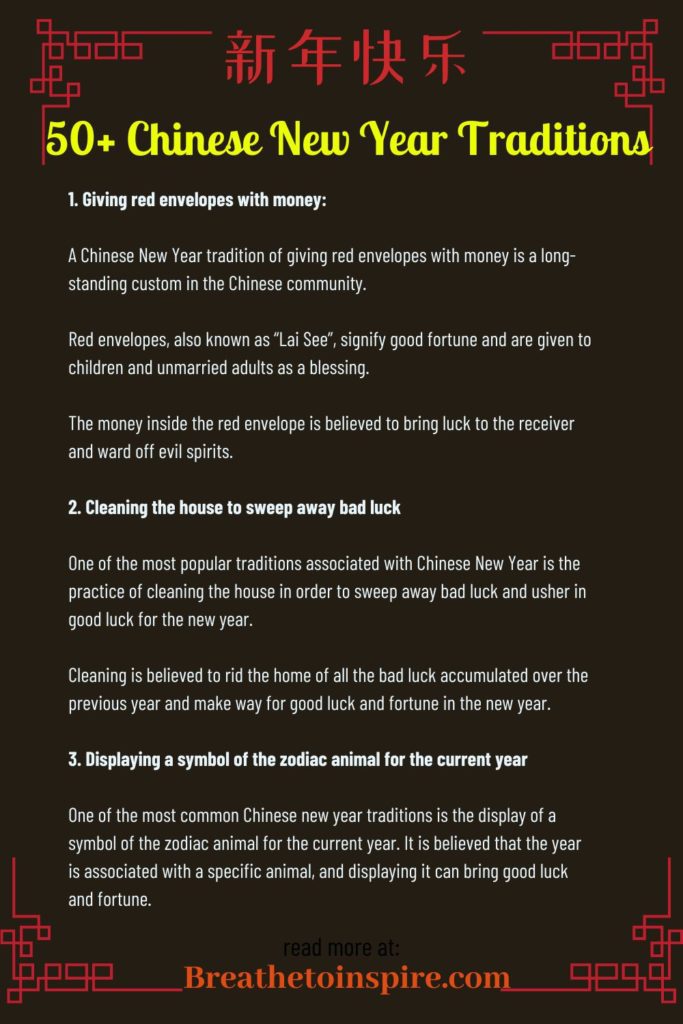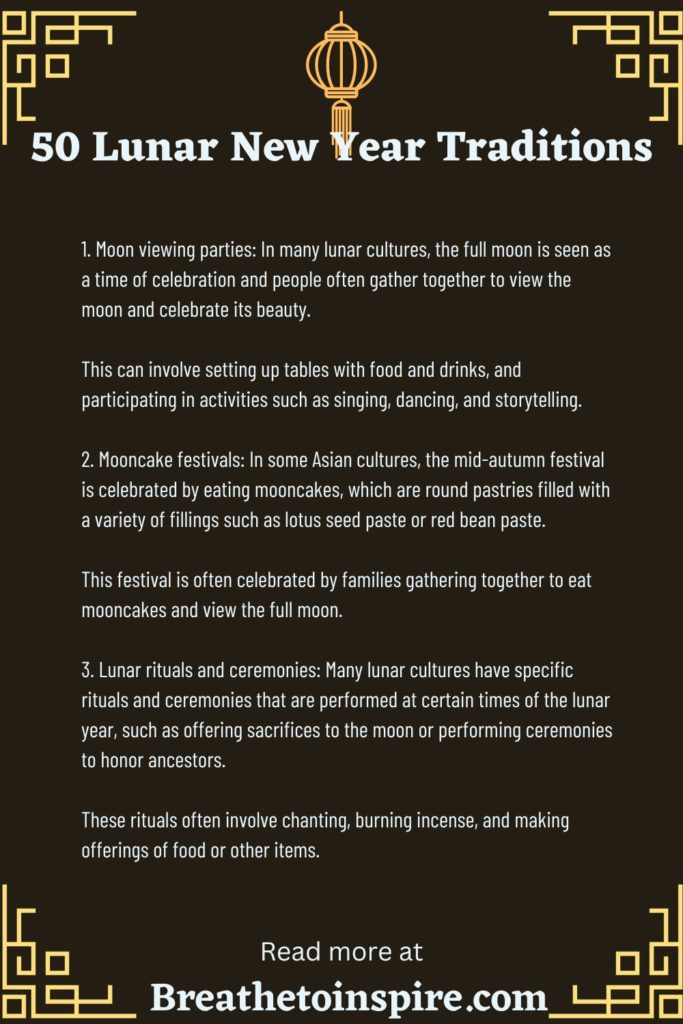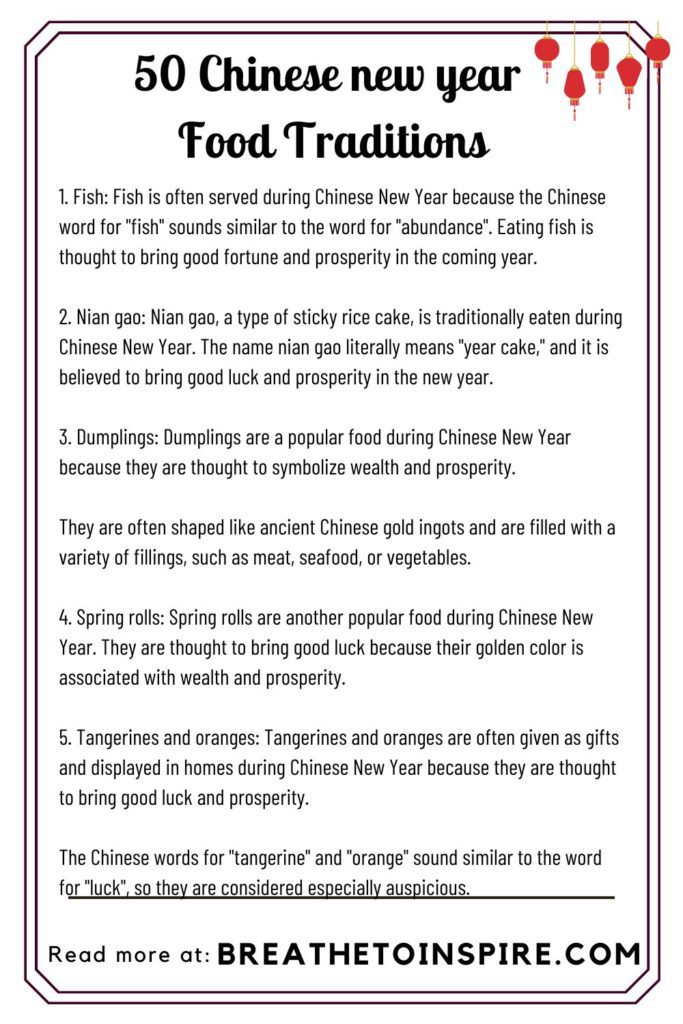Chinese New Year is one of the most important events in the Chinese calendar, celebrated by millions of people around the world.
It is a time of joyous celebration and family reunions, with a wide range of Chinese new year traditions, customs and activities. From food traditions and clothing traditions to gift-giving, celebration rituals, and good luck traditions, the Lunar New Year and the Spring Festival offer a unique opportunity to connect with culture and history.
In this blog post, we will explore the many traditions associated with Chinese New Year, from the Reunion Dinner that marks the first day of the celebration, to the traditional clothing worn to bring in the New Year, to the symbolic gifts exchanged among family and friends.
All of these customs and activities are rooted in ancient tradition and are designed to bring good luck and prosperity for the upcoming year.
- 50+ Chinese new year traditions
- Lunar new year traditions
- Chinese new year food traditions
- Chinese New Year clothing traditions
- Chinese New Year gift traditions
- Best Chinese festival traditions
- Chinese spring festival traditions
- Chinese New Year celebration traditions
- Chinese New Year Good Luck traditions
- Chinese New Year reunion dinner traditions
- Japanese lunar new year traditions
- Malaysian chinese new year traditions
- Chinese new year family traditions
- Chinese new year traditions for married couples

50+ Chinese new year traditions
The following is a list of Chinese new year traditions and customs:
1. Giving red envelopes with money
A Chinese New Year tradition of giving red envelopes with money is a long-standing custom in the Chinese community.
Red envelopes, also known as “Lai See”, signify good fortune and are given to children and unmarried adults as a blessing.
The money inside the red envelope is believed to bring luck to the receiver and ward off evil spirits.
The amount of money given in each red envelope varies, but is typically in even numbers to represent good luck.
Red envelopes are usually given out during the New Year festivities, which are celebrated for fifteen days.
2. Cleaning the house to sweep away bad luck
One of the most popular traditions associated with Chinese New Year is the practice of cleaning the house in order to sweep away bad luck and usher in good luck for the new year.
Cleaning is believed to rid the home of all the bad luck accumulated over the previous year and make way for good luck and fortune in the new year.
Many Chinese families take the time to thoroughly clean their homes and decorate with bright, vibrant colors to celebrate the holiday.
This practice is so popular that the first few days of the Chinese New Year are often called “Spring Cleaning Days.”
3. Displaying a symbol of the zodiac animal for the current year
One of the most common Chinese new year traditions is the display of a symbol of the zodiac animal for the current year. It is believed that the year is associated with a specific animal, and displaying it can bring good luck and fortune.
This symbol is often seen in the form of decorations, such as banners, paintings, and figurines, which are placed around the house.
It is also common to give gifts related to the animal, such as stuffed toys, jewelry, and even clothing
Displaying the symbol of the zodiac animal for the current year is a way to bring prosperity and good luck into the home for the new year.
Also read: 50 Lunar and Chinese new year Trivia questions and answers (2024 edition)
4. Not washing your hair or cutting it on New Year’s Day to maintain good luck
In China, it is a tradition to not wash one’s hair or cut it on the first day of the Chinese New Year. This is believed to be a way to maintain good luck and fortune throughout the year.
It is believed that if a person washes their hair or cuts it on the first day of the New Year, they will wash away the luck and prosperity that the New Year has to offer.
Therefore, people will refrain from doing any hair-related activities until the second day of the New Year, when it is considered safe to do so again.
People also often abstain from washing their clothes on the first day of the New Year, as it is believed that washing clothes on that day may also wash away good fortune.
5. Displaying a picture of the Kitchen God
The Kitchen God, or Zao Jun, is an important figure in Chinese culture and is widely celebrated during Chinese New Year.
The Kitchen God is the god of the hearth and is believed to protect the family from harm and bring good luck and prosperity.
On the 23rd day of the twelfth lunar month, families observe the Kitchen God’s departure to Heaven to report to the Jade Emperor on the family’s behavior throughout the year.
To ensure the Kitchen God’s favorable report, families make offerings of food, incense, and paper money to the Kitchen God on his departure day and show their appreciation for his protection and pray for a prosperous new year.
Also read: 150 Chinese new year questions to ask as icebreakers and conversation starters for 2024

Lunar new year traditions
Here is a list of Chinese lunar new year traditions:
1. Moon viewing parties: In many lunar cultures, the full moon is seen as a time of celebration and people often gather together to view the moon and celebrate its beauty.
This can involve setting up tables with food and drinks, and participating in activities such as singing, dancing, and storytelling.
2. Mooncake festivals: In some Asian cultures, the mid-autumn festival is celebrated by eating mooncakes, which are round pastries filled with a variety of fillings such as lotus seed paste or red bean paste.
This festival is often celebrated by families gathering together to eat mooncakes and view the full moon.
3. Lunar rituals and ceremonies: Many lunar cultures have specific rituals and ceremonies that are performed at certain times of the lunar year, such as offering sacrifices to the moon or performing ceremonies to honor ancestors.
These rituals often involve chanting, burning incense, and making offerings of food or other items.

Chinese new year food traditions
These are some of the interesting chinese and Lunar new year food traditions:
1. Fish: Fish is often served during Chinese New Year because the Chinese word for “fish” sounds similar to the word for “abundance”. Eating fish is thought to bring good fortune and prosperity in the coming year.
2. Nian gao: Nian gao, a type of sticky rice cake, is traditionally eaten during Chinese New Year. The name nian gao literally means “year cake,” and it is believed to bring good luck and prosperity in the new year.
3. Dumplings: Dumplings are a popular food during Chinese New Year because they are thought to symbolize wealth and prosperity.
They are often shaped like ancient Chinese gold ingots and are filled with a variety of fillings, such as meat, seafood, or vegetables.
4. Spring rolls: Spring rolls are another popular food during Chinese New Year. They are thought to bring good luck because their golden color is associated with wealth and prosperity.
5. Tangerines and oranges: Tangerines and oranges are often given as gifts and displayed in homes during Chinese New Year because they are thought to bring good luck and prosperity.
The Chinese words for “tangerine” and “orange” sound similar to the word for “luck”, so they are considered especially auspicious.
Also read: 50 Chinese New Year Activities 2024 (kids, adults, seniors edition)
Chinese New Year clothing traditions
The following are some Chinese New Year clothing traditions:
1. Wearing red clothes: Red is considered a lucky color in Chinese culture, and it is common for people to wear red clothing during the new year celebrations.
This includes red dresses, suits, and even red underwear and socks.
2. Customary Chinese-style clothing: Traditional Chinese clothing such as qipaos and cheongsams are popular choices for the new year, as they symbolize prosperity and good fortune.
3. New clothes: It is also a tradition for people to wear new clothes on the first day of the new year, as it is believed to bring good luck and fresh beginnings.
4. Wears Clothes with auspicious symbols: Many people choose to wear clothing with auspicious symbols such as the Chinese character for “luck” or the zodiac animal of the current year.
Chinese New Year gift traditions
These are a few Chinese New Year gift traditions:
1. Giving red envelopes (hongbao) filled with money: Red envelopes are given to children and unmarried adults as a symbol of good luck and prosperity for the new year.
2. Exchanging gifts of food: Traditional Chinese New Year gifts often include fruits such as oranges, tangerines, and pomelos, as they are believed to bring luck and good fortune.
Also read: 100+ Chinese and lunar new year captions, puns for social media posts and pictures
Best Chinese festival traditions
Decorating the home with red lanterns, paper cuttings, and couplets:
Red is believed to bring good luck and prosperity in Chinese culture, so it is common to decorate the home with red lanterns, paper cuttings with blessings written on them, and couplets (pairs of poetic phrases) hung on the door or walls.
Chinese spring festival traditions
Here is a list of Spring festival traditions during chinese new year:
1. Not using sharp objects on New Year’s Day to prevent cutting off good luck:
This is a common practice among many Chinese families and is rooted in superstition.
It is believed that using sharp objects on the first day of the new year can lead to misfortune, so many people avoid using knives, scissors, and other sharp objects on this day.
Some people even go as far as to avoid using pens or pencils to write on New Year’s Day.
2. Not borrowing or lending money on New Year’s Day to avoid financial difficulties in the new year:
This practice is also rooted in superstition. It is believed that borrowing or lending money on New Year’s Day will bring bad luck in the new year and lead to financial difficulties.
As such, many people choose to avoid this practice on New Year’s Day and wait until the following day to borrow or lend money.
Also read: 100 Chinese new year sayings for happiness, health, good luck and peace – 2024 edition
Chinese New Year celebration traditions
These are some Chinese New Year celebration traditions:
1. Participating in parades and Performing traditional lion and dragon dances.
One of the most beloved traditions during this holiday is participating in parades and festivals featuring colorful floats and costumes.
During these parades, participants dress up in traditional costumes and follow the floats and dragons as they make their way through the streets.
The floats are often decorated with vibrant colors and feature traditional Chinese characters, symbols, and images.
The dragons are also lavishly decorated and are believed to bring good luck and luck to the participants.
The parades and festivals are a great way to bring the community together, and they provide a unique opportunity to experience the vibrant culture of China.
2. Playing traditional games like mahjong and Chinese chess:
As part of the celebration, many people play traditional games like Mahjong and Chinese Chess.
Mahjong is an ancient four-player game that is popularly played on Chinese New Year and consists of tiles with different symbols.
Chinese Chess is a two-player board game that is believed to have originated from the ancient game of Go.
Both games are usually played by adults during the New Year celebration, and it is believed that playing these games helps bring in good luck and prosperity for the coming year.
Chinese New Year Good Luck traditions
Here is a list of Good luck Chinese New Year eve traditions:
1. Offering sacrifices to the gods and ancestors to bring good luck and prosperity:
During Chinese New Year celebrations, people pay their respects to gods and ancestors by offering sacrifices such as burning paper money, food, and incense.
This is believed to bring good luck and prosperity in the upcoming year.
2. Decorating the home with red and gold colors:
Red and gold are considered lucky colors in Chinese culture and are believed to bring good luck and prosperity.
During the Chinese New Year, people decorate their homes with red and gold decorations such as lanterns, banners, paintings, and other festive decorations.
3. Sending New Year’s greetings and well wishes to friends and family:
Sending New Year’s greetings and well wishes to friends and family is another important Chinese New Year tradition.
This can be done through cards, text messages, or other methods of communication. This is a way of expressing good wishes for the upcoming year and is believed to bring good luck and fortune.
Also read: 350 Chinese new year greetings (lunar and spring festival 2024 edition)
Chinese New Year reunion dinner traditions
Here is a list of Chinese New Year visiting traditions and reunion dinner traditions:
1. Remembering the ancestors through prayers and offerings:
During the reunion dinner, families will offer prayers and offerings to their ancestors in order to honor their memory and seek their blessings.
The offerings may include food, incense, and paper money.
2. Eating traditional reunion dinner:
A reunion dinner is typically a feast of traditionally prepared dishes, created to symbolize luck and prosperity.
The reunion tradition is believed to have originated from the myth of Nian, which teaches the importance of family reunions.
3. Exchanging Symbolic gifts:
Families exchange gifts during the reunion dinner in order to express their love and gratitude.
The gifts are usually in the form of Chinese paper-cuttings, lucky money, or symbolic items such as oranges and pomelos.
Japanese lunar new year traditions
These are a few japanese lunar new year traditions:
1. Hatsumode: The first shrine visit of the year is a special activity, often done on the first three days of the new year.
2. Osechi Ryōri: A traditional meal prepared for the New Year, containing a variety of tasty dishes, often served in special lacquer boxes.
3. Kodomo no Hi: Children’s Day, a special day to celebrate the children of the family.
4. Ozoni: A soup made with mochi (rice cakes), vegetables, and other ingredients.
5. Otoshidama: A traditional practice of giving children a small sum of money in a special envelope as a New Year’s gift.
6. Hatsuhinode: Watching the first sunrise of the new year.
7. Kagami Biraki: A traditional ceremony where family and friends gather to break open a sake barrel, symbolizing the wish for good luck and prosperity in the new year.
8. Mochitsuki: Making mochi (rice cakes) through a traditional pounding process.
9. Temizuya: A ritual purification fountain at the entrance of a shrine, where visitors wash their hands and rinse their mouth before entering.
10. Nengajō: New Year’s postcards.
Malaysian chinese new year traditions
Here is a list of Malaysian chinese new year traditions:
1. Avoiding the use of scissors and knives: This is to avoid “cutting” away any luck or prosperity that may come their way.
2. Eating Yusheng: A Malaysian Chinese dish consisting of raw fish salad with shredded vegetables, preserved fruits, and sauces.
3. Decorating the house and setting up a family altar – During the Chinese New Year, many Malaysian families will decorate their homes with traditional red and gold decorations, as well as setting up a family altar to honor their ancestors.
4. Visiting temples – Many Malaysians visit temples during the Chinese New Year to pray and seek blessings for the coming year. It is also a time to pay respect to ancestors and deceased loved ones.
5. Giving red packets – Red packets, also known as “ang pow”, are packets filled with money given as gifts to family members, friends and colleagues as a sign of luck and wealth.
Chinese new year family traditions
These are a few chinese new year family traditions:
1. Planting kumquat trees and displaying them in pots
2. Displaying potted mandarin orange or tangerine trees
3. Displaying red decorations and Chinese lanterns to bring good fortune.
4. Lighting incense to honor ancestors and bring good luck.
5. Setting off firecrackers to scare away evil spirits.
Chinese new year traditions for married couples
These are some of the good chinese new year traditions for married couples:
1. Participating in temple rituals: It is traditional for married couples to visit a temple on the first day of the Chinese New Year to pray for blessings, health and good luck for the new year.
2. Eating Together: On the day of Chinese New Year, married couples traditionally gather together to enjoy a meal to celebrate the start of the new year.
3. Giving Gifts: Married couples exchange gifts as a way to show their love and appreciation for each other.
